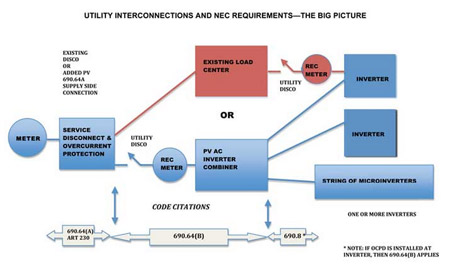 Inspectors and installers continue to puzzle over the requirements in Section 690.64 of the National Electrical Code (NEC) that apply to the connection of utility-interactive inverters to the premises wiring and finally to the utility. This article, using the simplified block diagram (figure 1), will attempt to clarify some of those requirements. Please refer to previous Perspectives on PV articles over the last two years for more detailed information.
Inspectors and installers continue to puzzle over the requirements in Section 690.64 of the National Electrical Code (NEC) that apply to the connection of utility-interactive inverters to the premises wiring and finally to the utility. This article, using the simplified block diagram (figure 1), will attempt to clarify some of those requirements. Please refer to previous Perspectives on PV articles over the last two years for more detailed information.
One Diagram Is Worth a Thousand Words
Many people do better with diagrams than they do with words, so the diagram shown should be just up their alley. This diagram works with many types of utility interactive PV systems. These systems all start with a meter connected to the utility as shown on the left. After that, we may be dealing with an existing service disconnect and the connected existing load center or with a PV supply side connection, which is just a second service entrance on the existing premises wiring system. In either case, the NEC requirements of Article 230 apply as noted at the bottom. In most jurisdictions, the local utility will require a PV disconnect on the ac output of the PV system and many areas will use a Renewable Energy Credit (REC) meter to measure the PV system output. As shown, one or more single inverters may be connected or even one or more “strings” of microinverters or AC PV modules may be connected to the added combining panel (blue blocks). Or, a single inverter could be connected to an existing load center (red blocks). In some cases multiple inverters might be connected through an ac combining panel and then backfeed an existing load center. Let’s start our examination of the requirements at the inverter end of the circuit.
Inverter Output Circuit
All utility-interactive inverters have a rated output current that cannot be exceeded. There are no surge currents in these output circuits andNEC690.8 requires that the circuit and the overcurrent protective device (OCPD) be rated at 125% of that rated output current. When the calculated OCPD value is a nonstandard value, the next standard higher value should be used, but not to exceed the maximum overcurrent value given in the technical specifications for the inverter. Conductor size should be selected so that it is protected by the OCPD rating.

Figure 1. Utility interconnections and NEC requirements
The asterisk (*) by the 690.8 in the diagram indicates thatifthere is an overcurrent device mounted at the inverter, then the requirements of 690.64(B),and not 690.8, will apply. Some installers and manufacturers use a circuit breaker or fused disconnect at the inverter to meet the requirements of 690.15 to have a maintenance disconnect at the inverter. The inclusion of an overcurrent device at this location generally forces the output conductors from the inverter to be larger [as required by 690.64(B)] than would otherwise be required by 690.8.
After the First Inverter Overcurrent Device
Anyconductor or busbarthat can have power flowing from more than one source of supply (under normal or fault conditions) such as the utility and a PV inverter, and where the conductor is protected by an overcurrent device on each supply source must meet 690.64(B) requirements. This is the long-standing 120% allowance [when 690.64(B)(7) conditions can be met]. Section 690.64(B) is going to apply to allconductors and busbarsfrom the first overcurrent device connected to the inverter output all the way to the service disconnect.
These busbars and conductors would include the busbars of any backfed main panelboards connected to one or two inverters or sets of microinverters, and any busbars in PV ac inverter combiner panels. The conductors or feeders between the panelboards or load centers and the main service disconnects are also subjected to the requirements of 690.64(B)(2) as noted on the diagram.
In general the ratings of all of the breakerssupplyinga busbar or conductor areaddedtogether and the sum is divided by 1.2 (for the 120% allowance). If the location requirements of 690.64(B)(7) cannot be met (PV breaker located at the opposite end of busbar or conductor from the

Photo 2. PV on south-facing roof at a good slope
utility breaker), then the sum may be divided by only 1, and the busbar rating or cable ampacity goes even higher. For example:
Two inverters each require a 50-amp backfed breaker in a main lug PV ac inverter combining load center to meet 690.8 requirements. A supply-side connection is going to be made with a 100-amp fused disconnect. The rating of the combining load center and the ampacity of the conductor to the 100-amp fused disconnect must follow the 690.64(B)(2) requirements.
(50 + 50 +100)/1.2 = 200/1.2 = 166.7 amps
The numbers indicate that a 200-amp PV ac inverter load center/panelboard would be needed and a 2/0 AWG conductor should be used between that panel and the 100-amp fused disconnect.
Now suppose that the two inverters are being backfed into an existing panelboard (switchgear) and it is not possible to position the two backfed PV breakers at the opposite end of the switchgear busbar from the main breaker. The requirements of 690.64(B)(7) are not met and the 120% allowance cannot be used. The equation becomes:
(50 + 50 + main breaker) must be less than or equal to the busbar rating.
If the main breaker were rated at 200 amps, then the busbar would have to be rated at 300 amps.
As the diagram shows, 690.64(B) applies to any panel or load center that has connections to the utility and to the PV inverter. It can be an existing load center or an added PV ac inverter combining panel.
The Main Disconnect and on to the Meter
Any circuit between the meter and the service disconnect would be considered a service-entrance circuit and be governed by the requirements of Article 230. This would be true if the circuit was an existing service- entrance conductor or a new 690.64(A) supply-side connection. The conductor size, type, and routing as well as the size and location of the service disconnect would have to meet 230 requirements. However, after passing through the overcurrent device on either an existing service disconnect or through the overcurrent device on an added PV supply-side connection, the requirements of 690.64(B) apply all the way to the first overcurrent device connected to the inverter output.
Summary
A diagram can simplify understanding of the requirements ofNEC690.64. While the PV industry had hopes of getting additional clarity into this section of the Code, those hopes were not realized for the 2011NEC, and we must continue to work with the existingCodelanguage.
For Additional Information
If this article has raised questions, do not hesitate to contact the author by phone or e-mail. E-mail: jwiles@nmsu.edu Phone: 575-646-6105
See the web site below for a schedule of presentations on PV and the Code.
A color copy of the latest version (1.91) of the 150-page,Photovoltaic Power Systems and the 2005 National Electrical Code: Suggested Practices, written by the author, may be downloaded from this web site: http://www.nmsu.edu/~tdi/Photovoltaics/Codes-Stds/Codes-Stds.html
The Southwest Technology Development Institute web site maintains a PV Systems Inspector/Installer Checklist and all copies of the previous “Perspectives on PV” articles for easy downloading. Copies of “Code Corner ” written by the author and published inHome Power Magazineover the last 10 years are also available on this web site: http://www.nmsu.edu/~tdi/Photovoltaics/Codes-Stds/Codes-Stds.html











Find Us on Socials